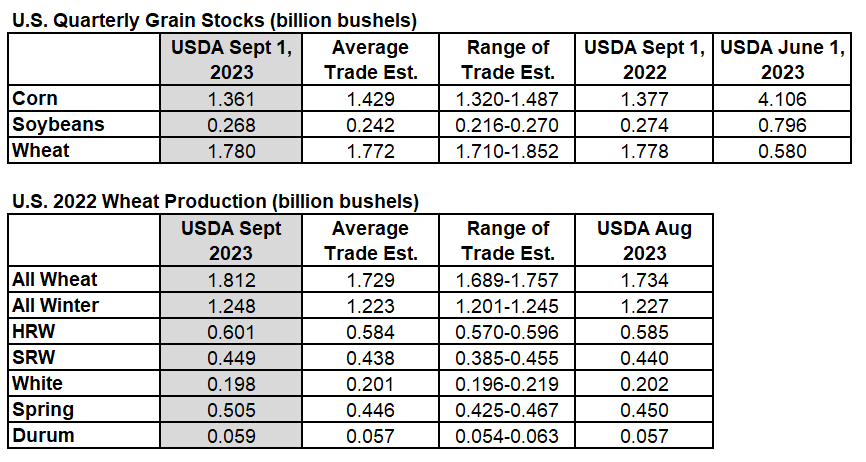More bean and wheat stocks than expected, less corn
Corn Stocks
Old crop corn stocks in all positions on September 1, 2023 totaled 1.36 billion bushels, down 1 percent from September 1, 2022. Of the total stocks, 605 million bushels are stored on farms, up 19 percent from a year earlier. Off-farm stocks, at 756 million bushels, are down 13 percent from a year ago.
The June – August 2023 indicated disappearance is 2.75 billion bushels, compared with 2.97 billion bushels during the same period last year.
Bean Stocks
Old crop soybeans stored in all positions on September 1, 2023 totaled 268 million bushels, down 2 percent from September 1, 2022. Soybean stocks stored on farms totaled 72.0 million bushels, up 14 percent from a year ago. Off-farm stocks, at 196 million bushels, are down 7 percent from last September. Indicated disappearance for June – August 2023 totaled 528 million bushels, down 24 percent from the same period a year earlier.
Comments
Corn prices were down 7-8 cents following the reports, while beans and wheat both quickly dropped 20 cents. Corn was no longer in a Sell Signal once prices were down more than a couple cents. KC and Minneapolis wheat remain in Buy Signals, and Chicago wheat will likely join then on Monday unless prices recover by the end of the day.
We remain concerned about the bean market and see multiple factors continuing to pressure price lower:
- The spec funds continue to liquidate their long positions. If the trend remains down, that will remain their normal pattern. The 26 million bushel larger than expected Stocks total today only accelerates this downward trend. If you are trend follower, it is hard to be long in this bean market.
- The fundamental risk is there is an abundance of global soybean supply. We are heading towards world ending stocks for soybeans being ample to burdensome. Sellers in South America will discount their prices to get their record productions sold and leave US sellers holding the bag.
- Our shipping costs are increasing. Low levels on both the Mississippi River and Panama Canal and driving US export costs higher.
- Rapidly advancing US harvest continues to exert pressure.
- Increasing political tension between US and China. If you want an indication of how that relationship is faring this week, China just said they want their panda bears back and they will no longer allow US zoos to display pandas.
Small Grains Summary
The big surprise from the USDA was a sharp increase in their 2023 US wheat production estimate. They increased their estimate by 78 million bushels to 1.812 million bushels, when trade expected a 5 million bushel decrease. Production estimates for all classes of wheat except White wheat exceeded trade expectations.

Source: USDA, Bloomberg, StoneX
